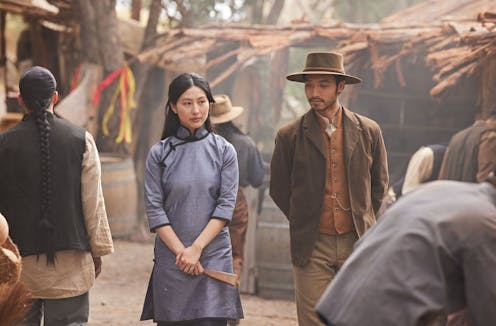a compelling murder mystery shines light on early Australian multiculturalism
- Written by Keir Reeves, Professor of History & Director Future Regions Research Centre, Federation University Australia

Review: New Gold Mountain, directed by Corrie Chen.
The beautifully shot and evenly paced New Gold Mountain, the new series from SBS, is an 1850s-era murder mystery set in the Ballarat goldfields during the gold rush heyday.
In 1851, gold was discovered in Ballarat – a little known pastoral outpost of the British empire. News of the strike quickly spread and the town rapidly developed. Initially, the first arrivals came from other parts of Victoria. Others followed from other Australian colonies. Soon after, international arrivals came from all regions of the globe and in 1852 many arrived from Southern China in search of gold.
New Gold Mountain focuses on this Chinese-Australian goldfields experience, primarily from the point of view of Leung Wei Shing (Yoson An), the brooding headman of the Chinese miners and his relationships with his younger, errant brother Leung Wei Sun (Sam Wang) and his loyal assistant Gok (Chris Masters Mah).
The narrative is widened to include Belle Roberts (Alyssa Sutherland), the English widow turned newspaper proprietor; Hattie (Leonie Whyman), the resilient Indigenous woman trying to get by; and Patrick Thomas (Christopher James Baker), the troubled Irish miner whose wife’s disappearance drives the plot.
In their own ways, each character is caught between different cultures, friendships and allegiances in the rapidly forming goldfields frontier society on the far side of the world.
A Chinese Australian tale
Chinese migration patterns to Australia were largely based on regional associations, particularly in the localities of Toi Shan, Sze Yup and Sam Yup in Guangdong, Southern China. These regional associations and “brotherhoods”, as they are referred to in the series, were labour recruiting mechanisms similar to the one Wei Shing runs at this Chinese camp.
Here, Cheung Lei (Mabel Li) brings into play the connections, allegiances and complexities between Chinese gold seekers in the Australian colonies and their backers in China.
On one hand, relations between key characters and groups (primarily between the Chinese and Europeans) are typified by racism and hostility. But there is also cooperation, as Wei Shing and Belle unite to solve the murder. Sometimes there is brutal friendship, as when Wei Shing and the Chinese protector, Standish (Dan Spielman), finally establish exactly where they stand with each other.
Director Corrie Chen and creator Peter Cox pull no punches while maintaining a compelling murder mystery and this lively ensemble offers a nuanced reading of the Australian goldfields experience, telling a mature and ambiguous account of the frontier.
The other stars of the series are the distinctive former mining landscapes and Sovereign Hill providing the visual backdrops for the 1850s goldfields society. You can imagine how startled recent arrivals from the bustling South China trading ports of Guangzhou, Hong Kong and Macau must have been on disembarkation. The flora and fauna – literally everything – was so different to home.
Chen explores this shock in a moment of brief magical realism with Wei Shing’s encounters with a kangaroo. It seems the bush sees all. The Chinese miners and their Indigenous and European counterparts were all coming to terms with a landscape broken by mining and colonised by a disparate society coming to terms with its own experiences and opportunities. New Gold Mountain evocatively captures this moment.
Read more: Friday essay: the story of Fook Shing, colonial Victoria's Chinese detective
The gold rush on screen
Australian goldfields life has been shown on television before, notably Rush, the Victorian gold rush era drama from the 1970s.
But the obvious cultural point of reference is Deadwood (2004-06), David Milch’s multi-layered historical narrative based on the 1850s gold-rush town in the Black Hills Indian Cession, a region that subsequently became South Dakota.
Much of Deadwood centres on the business dealings between the Chinese headman, Mr Wu, and the corrupt saloon owner and town powerbroker, Al Swearengen. The inherent racism of frontier life is apparent, as is the mutual respect the two men have for each other as they seek to benefit from nefarious business dealings.
Similar complex, intertwined plots of shifting alliances and a mutual desire to win money run through New Gold Mountain.
On closer viewing, the series also shares a watermark with the New Zealand made Illustrious Energy (1988), directed by Leon Narbey, which also explored the goldfields experience from a Chinese perspective. Other Australian colonial stories have been told in John Hillcoat’s The Proposition (2005) and Jennifer Kent’s recent The Nightingale (2018).
Yoson An’s smouldering portrayal of Wei Shing resembles Jay Swan’s character in Mystery Road (2018–). Both are extremely resourceful, conflicted and move between different worlds while confronting the ghosts of their own respective pasts in remote Australia.
Historical voices together
New Gold Mountain emphasises the little told history of the Chinese on the diggings. The paradoxical nature of the colonial gold seeking era is best understood when all the historical voices are heard together. If one story dominates, much of the historical themes which help to explain Australian society in the present day are missed.
The show also reminds us of the complex enduring relationship between China and Australia, which has often been driven by the mining industry.
But, ultimately, it’s a cracking murder mystery that reminds viewers the first Australian multicultural moment happened in the mid-19th century – not the 20th.
New Gold Mountain premieres on SBS Wednesday 13 October.
Authors: Keir Reeves, Professor of History & Director Future Regions Research Centre, Federation University Australia





